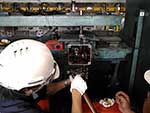
Most people are familiar with Self-Monitoring, Analysis and Reporting Technology (SMART technology)—in the form of many consumer devices such as mobile phones, fitness wristbands, and home thermostats. Companies in the manufacturing industry are rapidly incorporating this technology into everyday operations with a network of small, affordable, internet-connected computers and sensors (IIoT). Applying these internet-enabled, data-driven devices to the industrial space allows manufacturers to automate and improve operations in ways that were unimaginable, even as recently as a decade ago.
The global Industrial Internet of Things market is expected to exceed $205 billion by 2024. This number clearly shows that smart equipment is already being incorporated into modern manufacturing operations to improve efficiency and increase profitability. However, there can be obstacles involved with effectively implementing an IIoT program in a metalworking plant.
Manufacturing industries all over the globe are the leading investors in IIoT. They are using industrial sensors, beacons, advanced RFID tags, connected equipment and more to collect and analyze data from multiple data points to optimize a myriad of manufacturing processes. While the majority of these businesses have already seen a positive return on investment, only about a third of decision-makers have a strategy in place, and fewer have a comprehensive plan for making use of it in the future.
Several factors that contribute to the slow pace of IIoT adoption have been identified by business strategist and industry analyst Daniel W. Rasmus:
Run-to-failure and preventive maintenance are perceived as “good enough”
The perceived cost of IIoT transformation and the lack of solid data about benefits keeps firms doing what they have always done.
Displacement of workers
The typical factory maintenance worker is not the customer of IIoT solutions. New skills are required to manage data collection, data security, machine-learning, predictive analytics and the ability to see the factory as an integrated whole rather than a collection of individual pieces of equipment.

The software isn’t good enough yet.
The entire IIoT market remains in start-up mode, and some vendors are delivering sub-par software. Essentially, quality programs that pervade modern manufacturing need to be adopted by IIoT vendors as a key principle. Software must reliably and consistently gather data, provide meaningful insights and transform those insights into actions that reduce overall costs by increasing reliability.
A better understanding of IIoT is the key to addressing these factors and moving an operation toward the future. Fortunately, there are equipment and software experts that are already delivering IIoT solutions to the industry. They can help metalworking operations understand the technology and avoid the biggest detriment to efficiency and profitability: downtime of equipment and systems.
The basis of IIoT involves a shift from preventive maintenance to predictive maintenance. The ineffectiveness of preventive maintenance should no longer be acceptable when a viable alternative exists. Predictive maintenance with IIoT uses the real-time, current condition of equipment to determine when service is required. The days of studying old data and guessing about service intervals are over because of predictive maintenance.

Preventative Maintenance
• Performed whether the equipment or system needs it or not
• Labor-intensive and unreliable
• Ineffective in identifying problems developed between inspections
• A reactive approach to breakdowns

Predictive Maintenance
• Based on real-time data and correlations
• Performed if needed
• Performed when the maintenance is most cost-effective
• Performed before equipment loses effectiveness
All equipment within a metalworking operation can benefit from SMART Technology- from front line production equipment to back-end systems. Prioritizing the latter systems that process scrap metal and spent fluid will maximize efficiency, profit margins and overall business value.
Automating as many plant systems as possible not only addresses staffing issues, but offers other advantages that can directly benefit the bottom line. Implementing IIoT capability can achieve the same results, provided an operation fosters a culture that encourages collaboration between humans and machines.
Regarding any software fears, there are platforms available today that are capable of enabling companies to integrate, connect, and manage millions of IIoT components by operating connected business processes and consuming connected insights. When implemented on equipment throughout the plant, these platforms allow metalworking companies to make business decisions that affect positive operational changes, reduce risks, and increase revenue.
The software can operate across the cloud or on-premises and provides enterprises with total freedom and choice in designing, building, deploying and evolving their IIoT implementations seamlessly across any network. The ultimate objective is to help customers eliminate metalworking waste and improve the overall efficiency of their operations so they can increase their business profitability.

The Industrial Internet of Things is quickly becoming a reality in the manufacturing industry, with IIoT-related investments expected to be well into the billions within the next five years. However, many operations continue to lag behind when it comes to implementing this technology. Reasons for this range from being wary of the technology’s reliability and effectiveness at this stage of its development to being satisfied with the way things have traditionally been done in metalworking plants.
Resistance to change should never be a barrier to innovation, especially when the advantages are tangible and solutions exist that can put most fears related to IIoT to rest. Working with a systems provider that is ahead of the curve and offers a proven, reliable software platform for its waste stream processing equipment can help a metalworking operation stay competitive by getting the maximum advantage and uptime from IIoT technology.
White Paper: ‘Getting the Most Value from Metal Scrap and Spent Fluids’ In this paper, we examine some of the factors that can significantly impact profit margins for metalworking shops. Additionally, we will make the case for minimizing that impact with metal scrap processing equipment and fluid recycling systems. Read our white paper